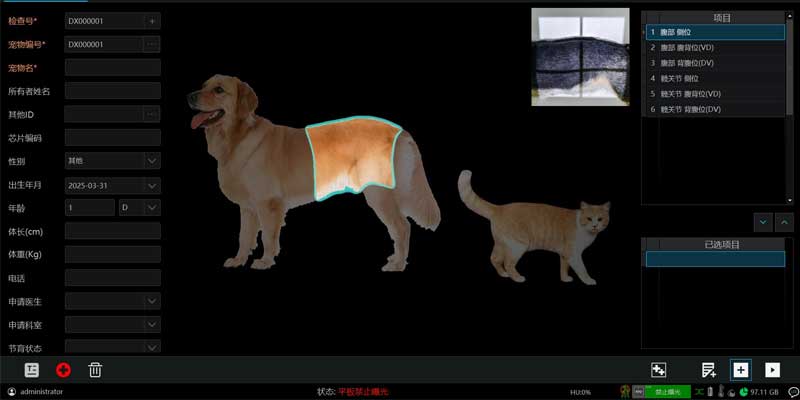Simply put, DR stands for “Digital Radiography.” It’s similar to an X-ray in human medicine but uses more advanced technology: it produces images faster and with higher clarity, allows for direct viewing and analysis on a computer, and involves less radiation than traditional X-rays, making it safer for both pets and veterinarians.
What issues can DR detect in pets?
DR is like taking a “transparent photo” of a pet’s body, revealing many hidden problems beneath the skin and muscles:
- Bone issues: One of the most common uses. For example, if a dog’s leg hurts after jumping off the couch, it could be a fracture or bone crack; if a cat limps, it might be a joint dislocation or arthritis; DR can also clearly show osteoporosis or bone spurs in older pets.
- Lung and respiratory diseases: When pets cough or have difficulty breathing, DR helps veterinarians diagnose pneumonia, pulmonary edema, tracheal foreign objects (e.g., a small bone stuck in the throat), or even lung tumors.
- Digestive abnormalities: If a pet vomits or refuses to eat, DR can detect foreign objects in the stomach (e.g., swallowed yarn or toys), intestinal blockages, or emergencies like gastric dilation or intussusception.
- Heart and chest issues: DR can also provide preliminary screening for an enlarged heart, fluid in the chest, or tumors, serving as a reference for further examinations (e.g., cardiac ultrasound).
- Other hidden problems: For instance, stones (bladder or kidney stones), changes in organ size, or even internal foreign objects (e.g., accidentally swallowed needles or small beads) may be visible in DR images.
When should a pet undergo a DR examination?
A veterinarian may recommend a DR examination if a pet exhibits the following symptoms:
- Trauma (e.g., hit by a car, falling from a height);
- Persistent coughing, difficulty breathing, or fever;
- Vomiting, diarrhea, or prolonged constipation;
- Abnormal gait or limb pain;
- Routine check-ups for older pets to screen for chronic diseases.
What should you pay attention to when getting a DR scan for your pet?
- Restraint is necessary: Pets must remain still during the DR scan to avoid blurry images. If the pet is uncooperative, a veterinarian or owner may need to gently hold them in place. In rare cases, mild sedation might be required (veterinarians will assess the situation and ensure safety).
- Radiation protection: Although DR involves low radiation, veterinarians and owners nearby will wear lead aprons and caps to avoid unnecessary exposure.
Post time: Sep-18-2025




